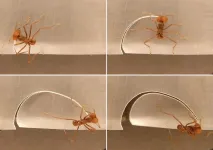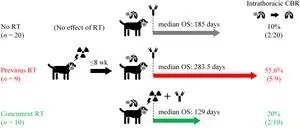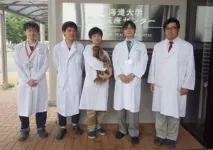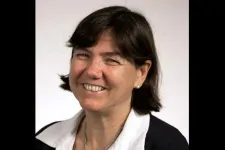Mystery of how leaf-cutting ants gauge leaf portion size revealed
How leaf-cutting ants carve leaf portions
2023-06-23
(Press-News.org) They might not be able to leap tall buildings with a single bound, but leaf-cutting ants are insect superheroes, capable of carrying leaf pieces up to six times their body mass to cultivate fungus in their borrows. But how do the charismatic creatures determine the size of the fragments they carve with their mandibles? Do they use their bodies as a simple ruler, or do they use information about the position of their bodies to adjust how far they cut, adapting to the thickness of a leaf while dismembering it? Knowing that the insects alter the trajectory of a cut when sculpting ®Parafilm of different thicknesses, Flavio Roces from the University of Würzburg, Germany, decided to find out how the ants govern the size of the portions they trim. He and his colleagues, Daniela Römer and Rebecca Exl (also from University of Würzburg), publish their discovery in Journal of Experimental Biology that each ant keeps track of the position of the leaf edge by gripping it with their rear legs while pivoting their bodies as they trim to cut perfect leaf portions.
But first the researchers needed to understand with how the insects snip out regular leaf fragments. Exl fashioned fake leaves from ®Parafilm – one layer for thin leaves (0.13 mm), three for thick leaves (0.38 mm) – rubbed them with crushed bramble leaves or rose oil to make them more appealing to the ants and installed them in the foraging area of a lab-based Atta sexdens ant colony. As soon as an ant climbed aboard, Exl retrieved the pseudoleaf and positioned it in front of a camera to record the ant’s manoeuvres.
Initially, the ant lay along the edge of the leaf, with the hind and middle leg on the side nearest the edge gripping the ®Parafilm. Then, it snipped upward, gradually rotating its body until upright as it cut in an arc, attaching the second hind limb when its body was almost vertical. As the ant continued cutting, it rotated further, eventually releasing the first hind limb from the leaf edge while still holding on with the second hind limb, until it severed the chunk by cutting through the leaf edge after swivelling the body through 180 deg. And when Exl compared the ants’ posture as they cut through thick and thin leaves, she realised that they adapted their technique, crouching their legs to reduce their reach to cut smaller elliptically shaped fragments when provided with thick leaves.
So how were the ants controlling the size of the fragments they incised? Could knowledge about the position of their hind legs gripping the leaf edge guide their cutting trajectory? This time, Exl waited until each ant was halfway through a cut before gently inserting a piece of paper between the ant and the fake leaf to release its grip as it continued snipping. Without knowledge of the position of their legs relative to the leaf edge, some of the ants cut smaller elliptical portions. They were using information provided by their hind legs gripping the leaf edge to guide the trajectory of their cut. However, some ants were still able to cut similarly sized fragments. Were they using some other sensory information to guide their trajectory? Could hairs at the front of the neck, which detect the position of the head, contribute to their sense of cutting direction?
Exl cautiously shaved off these hairs and allowed the ants to cut a ®Parafilm leaf while gently detaching the insect’s limbs from the edge with the paper guard, and this time the ants completely lost track of direction, producing randomly shaped fragments that were nothing like the elliptical pieces they had cut previously. Leaf-cutting ants depend on knowledge of the location of the leaf edge provided by their legs, and the position of their heads, to keep them cutting on the curve and ensure that they never excise fragments that exceed their exceptional strength.
***********************************
IF REPORTING THIS STORY, PLEASE MENTION JOURNAL OF EXPERIMENTAL BIOLOGY AS THE SOURCE AND, IF REPORTING ONLINE, PLEASE CARRY A LINK TO: https://journals.biologists.com/jeb/article-lookup/doi/10.1242/jeb.244246
REFERENCE: Römer, D., Exl, R. and Roces, F. (2023). Two feedback mechanisms involved in the control of leaf fragment size in leaf-cutting ants. J. Exp. Biol. 226, jeb244246. doi:10.1242/jeb.244246
DOI: 10.1242/jeb.244246
This article is posted on this site to give advance access to other authorised media who may wish to report on this story. Full attribution is required and if reporting online a link to https://journals.biologists.com/jeb is also required. The story posted here is COPYRIGHTED. Advance permission is required before any and every reproduction of each article in full from permissions@biologists.com.
THIS RESEARCH ARTICLE IS EMBARGOED UNTIL THURSDAY, 22 JUNE 2022, 18:00 HRS EDT (23:00 HRS BST)
END
ELSE PRESS RELEASES FROM THIS DATE:
2023-06-22
Out to Innovate is proud to announce the winners of its 2023 recognition awards for lesbian, gay, bisexual, transgender, and queer (LGBTQ+) professionals in science, technology, engineering, and math (STEM). Out to Innovate has recognized exemplary individuals with LGBTQ+ Educator, Engineer, and Scientist of the Year for over 15 years.
2023 LGBTQ+ Educator of the Year: Ramón S. Barthelemy, Ph.D
The LGBTQ+ Educator of the Year award recognizes an educator who has significantly impacted STEM students through teaching, ...
2023-06-22
Leesburg, VA, June 22, 2023—According to an accepted manuscript published in ARRS’ own American Journal of Roentgenology (AJR), preferential use of pulmonary MR angiography (MRA) for diagnosing pulmonary embolus (PE) in the general population helped conserve iodinated contrast media during the 2022 shortage.
“This single-center experience demonstrates use of pulmonary MRA as a practical substitute for pulmonary CTA in emergency settings,” concluded lead investigator Jitka Starekova, MD, from the radiology ...
2023-06-22
Influenza A is one of two influenza viruses that fuel costly annual flu seasons and is a near constant threat to humans and many other animals. It's also responsible for occasional pandemics that, like the one in 1918, leave millions dead and wreak havoc on health systems and wider society.
Influenza A was first identified as a health threat nearly a century ago, but only in the last decade have scientists identified one of the virus’s key proteins for infiltrating host cells and short-circuiting their defenses. Now, a team of researchers at the University of Wisconsin–Madison have taken a major step toward understanding how that protein works, ...
2023-06-22
If we’ve learned anything from HBO’s smash hit Succession over the last four years, it’s that, as the authors of a new Strategic Management Journal article state, “Even the most powerful individuals do not work alone.” Given that, whether (SPOILER ALERT!) Tom succeeds in his new role depends less on his business acumen than on who the new CEO has as his allies.
In the upcoming article “Can powerful allies protect the CEO against performance declines? The role of the CEO’s subgroup power in CEO dismissal,” authors Jihae You, Taekjin Shin, and Yunhyung Chung, explore ...
2023-06-22
Historian Tamika Nunley can see the U.S. Supreme Court through the window of her office in the Library of Congress in Washington, D.C., where she is serving as the library’s Cary and Ann Maguire Chair in Ethics and American History this summer. It’s a great vantage point, she said, not only for looking out at landmarks of American government, but also for reflecting on the ways laws and judgements have negatively influenced Black maternal health throughout American history.
“I think the Library of Congress is one of the most democratic institutions we have, one of the best examples of what is possible in our democracy,” said Nunley, ...
2023-06-22
Just as space holds infinite mysteries, when we zoom in at the level of biomolecules (one trillion times smaller than a meter), there is still so much to learn.
Rensselaer Polytechnic Institute’s Catherine Royer, Constellation Chair Professor of Bioinformatics and Biocomputation at the Shirley Ann Jackson, Ph.D. Center for Biotechnology and Interdisciplinary Studies (CBIS) and professor of biological sciences, is dedicated to understanding the conformational landscapes of biomolecules and how they modulate cell function. When biomolecules ...
2023-06-22
CLEVELAND - A Cleveland Clinic research team recently published an “atlas” of metabolites associated with cardiovascular disease in the European Heart Journal. The novel findings provide key details about the routes and potential branching paths taken by bacteria and metabolic by-products, metabolites.
The study mapped out the multiple by-products of bacteria processing amino acids associated with cardiovascular disease and then compared that to patient data to assess disease risk in two large cohorts – one in the US and another in Europe.
Bacteria in and on our bodies produce metabolites through processing certain molecules, referred to as precursors. ...
2023-06-22
A multi-nation cohort analysis found that inflammation and cesarean section delivery in mothers with higher body mass index are connected to shorter duration of breastfeeding, providing potential targets for intervention.
Breastfeeding has significant benefits for both maternal and child health. Research has indicated that women with higher body mass index (BMI) have shorter durations of breastfeeding, but few underlying mechanisms have been identified. To address this gap, a new study led by investigators from Brigham and Women’s ...
2023-06-22
For creating technologies that have the potential to change the world and providing opportunities for future inventors, Muhammad Rabnawaz, an associate professor and Faculty Laureate in the College of Agriculture and Natural Resources at Michigan State University, will be inducted into the National Academy of Inventors as a senior member on June 26.
The NAI senior member program was established to highlight academic inventors who have demonstrated a prolific spirit of innovation in creating or facilitating outstanding inventions that hold the promise of making a tangible impact on the public’s quality of life, economic development and the welfare of society. Election ...
2023-06-22
The human nose, which has around 6 million olfactory receptors, can distinguish between at least 1 trillion different odors. Dogs have about 300 million of these receptors, with some scientists estimating their sense of smell is up to 100,000 times more powerful than humans’. This allows dogs to detect the scent of dangerous materials like bombs and illicit substances, as well as medical conditions such as COVID-19 and Parkinson’s disease.
University of Arizona assistant professor Judith Su is developing an optical nose “as sensitive as ...
LAST 30 PRESS RELEASES:
[Press-News.org] Mystery of how leaf-cutting ants gauge leaf portion size revealed
How leaf-cutting ants carve leaf portions






